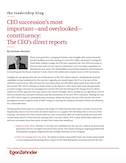Often, the board is eyeing the clock while trying to nudge the CEO into a graceful exit. Few CEOs are ready to leave on their own; it is too easy for retirement to be one major acquisition or blockbuster year away. The shareholders are growing impatient and are poised to second-guess the board, whatever it does. Such is the subtle and complex dance of CEO succession.
Notably, the one group often left out of this picture is the CEO’s direct reports—including the internal candidates being considered for the top role. Logically, one would expect the N-1s to be part of this collective conversation. After all, how the succession plays out will affect them much more than it will the current CEO, who is retiring no matter what, or the directors, who retain their seats. But generally, so much energy is focused on managing the current CEO and the timing of the change that the direct reports are all but ignored. This may seem to be a small oversight, but it actually incurs significant costs in terms of morale, key executive retention and the smoothness of the new CEO’s transition. Making the care of a CEO’s direct reports a priority during succession allows the board, the new CEO and the rest of the management team to spend more of their energy on moving the company forward at what can otherwise be a vulnerable time.
Having spoken with many N-1s waiting in the wings, I’ve observed that they share a number of concerns. Importantly, this is true even when the direct report is in a support role that keeps him or her out of the running—succession hits their careers with the same uncertainty, after all. Unfortunately, decorum and custom keep most N-1s from directly voicing what is on their minds. If N-1s were asked what makes for a well-run succession from their point of view, this is what they would say:
- Help me shine. N-1s—whether or not they are candidates for the top slot—need to be proactively groomed to be the strongest executives they can be. This means having an ongoing professional development program aligned with the strategic direction of the company.
- Don’t try keeping me in the dark. The desire to avoid a very public horse race leads many boards to overcompensate by leaving direct reports in the dark during the succession period. But this rarely succeeds. The internal candidates need to be told of their status so that the board knows they will accept the CEO position if offered, and the N-1s not in the running are usually self-aware enough to know that—and to have figured out who the finalists are. Boards would be better served if they treated those on the sidelines like adults, explaining the board’s reasoning in choosing the internal candidates, reviewing the criteria to be used in making a final decision and even soliciting input. The remaining N-1s will play a key role in the new CEO’s success; seeking their buy-in of the process builds the foundations for a better transition later.
- Let the NEDs decide. Not long ago, it was presumed to be the CEO’s right to name his or her successor. Today, while the CEO obviously has a role in guiding the trajectories of the frontrunners, the final decision should rest with the board’s nominating/governance committee. However, this can be easier said than done and requires considerable restraint by the incumbent CEO.
- If you want me to stay, make me an offer. The board should assume that every direct report (aside from whomever is named CEO, of course) will be presented with multiple offers from rival firms once the announcement is made. This is when executives’ stock is highest, and retaining them will require a concrete plan centered on opportunities for growth and impact that are hard to walk away from.
Too often, a CEO’s direct reports are the forgotten players in the succession drama—which is ironic since it is they, rather than the departing CEO, who represent the future of the company. Although it requires extra effort on the part of the board, sensitivity to the needs of this group will pay dividends during a critical time in a company’s trajectory.

CEO Succession’s Most Important — and Overlooked — Constituency: The CEO’s Direct Reports
Download as PDF





